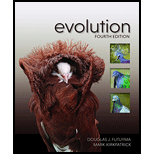
Concept explainers
To distinguish: Between the rate of
Introduction: Diversity is defined as the number of species or genera in many evolutionary studies. Analysis of changes in diversity can be done by studying paleontology and by the phylogenetic relationship among the species. Changes in speciation and diversification can be studied using a number of taxa (N). Speciation rate is represented as S while diversification rate is represented as D.
Explanation of Solution
The differences between the rate of speciation and diversification rate are mentioned as follows:
| No. | Character | Rate of Speciation | Rate of Diversification |
| 1. | Definition | Speciation rate refers to the probability of one species “giving birth” to another species over a short period of time represented as dt. | Diversification rate is defined as the average increase or decrease in diversity per taxon. |
| 2. | Representation | Speciation rate is represented by S. | D is used to represent the rate of diversification. |
| 3. | Calculation | Rate of speciation can be calculated by dividing the change in the number of species per unit time. | Subtracting speciation rate from extinction rate gives the rate of diversification. |
To explain: The relationship between the rate of speciation, a number of species and the rate of diversification.
Introduction: Diversity is defined as the number of species or genera in many evolutionary studies. Speciation rate refers to the probability of one species “giving birth” to another species over a short period of time which is represented as dt. Diversification rate is defined as the average increase or decrease in diversity per taxon.
Explanation of Solution
Subtracting speciation rate from extinction rate gives a rate of diversification represented as D. Speciation rate would be greater than the extinction rate if the value of D is greater than 1. A decline in the number of species would be observed if the value of D is negative. There will be an exponential increase or decrease in the number of species if the value of D remains constant over a period of time.
Want to see more full solutions like this?
- Which of the types of speciation is considered the (far) more common mechanism of species formation?arrow_forwardContrast allopatric speciation with sympatric speciation, and explain how each method may result in the creation of a new species.arrow_forwardIn what theory of speciation do new species emerge within the geographic range of their ancestors?arrow_forward
- Differentiate between allopatric speciation by dispersaland by vicariance, and give an example of each.arrow_forwardDefine speciation and the role of genetic divergence among populations in creating new species.arrow_forwardexplain the difference between allopatric and sympatric speciation, and describe each process?arrow_forward
- Distinguish between morphological, phylogenetic, and biological species concepts. What are the advantages and disadvantage of each? What notion is common to each of the species defintions that we considered? Why do species definitions matter in conservation biology?arrow_forwardWhat is the relationship between the concept of reproductive and geographical isolation and the concept of species? Illustrate and give concrete examples.arrow_forwardExplain the difference in behaviors of temporally isolated species when it comes to Allopatric vs Sympatric speciation.arrow_forward
- What are the most common mechanism of sympathric speciation and in which major group of organisms does this happen most often? Distinguish between sympathric and allopathric and parapathric speciation. Which is considered the (far) more common mechanism of species formation? What does "gene flow"between populations do?arrow_forwardDefine the concept of Macroevolution and Speciation ?arrow_forwardWhat do paleontological studies show about the relationship be-tween the geographic range of a species and its probability of un-dergoing speciation or extinction? How does this relationship present a paradox for biodiversity?arrow_forward
 Human Anatomy & Physiology (11th Edition)BiologyISBN:9780134580999Author:Elaine N. Marieb, Katja N. HoehnPublisher:PEARSON
Human Anatomy & Physiology (11th Edition)BiologyISBN:9780134580999Author:Elaine N. Marieb, Katja N. HoehnPublisher:PEARSON Biology 2eBiologyISBN:9781947172517Author:Matthew Douglas, Jung Choi, Mary Ann ClarkPublisher:OpenStax
Biology 2eBiologyISBN:9781947172517Author:Matthew Douglas, Jung Choi, Mary Ann ClarkPublisher:OpenStax Anatomy & PhysiologyBiologyISBN:9781259398629Author:McKinley, Michael P., O'loughlin, Valerie Dean, Bidle, Theresa StouterPublisher:Mcgraw Hill Education,
Anatomy & PhysiologyBiologyISBN:9781259398629Author:McKinley, Michael P., O'loughlin, Valerie Dean, Bidle, Theresa StouterPublisher:Mcgraw Hill Education, Molecular Biology of the Cell (Sixth Edition)BiologyISBN:9780815344322Author:Bruce Alberts, Alexander D. Johnson, Julian Lewis, David Morgan, Martin Raff, Keith Roberts, Peter WalterPublisher:W. W. Norton & Company
Molecular Biology of the Cell (Sixth Edition)BiologyISBN:9780815344322Author:Bruce Alberts, Alexander D. Johnson, Julian Lewis, David Morgan, Martin Raff, Keith Roberts, Peter WalterPublisher:W. W. Norton & Company Laboratory Manual For Human Anatomy & PhysiologyBiologyISBN:9781260159363Author:Martin, Terry R., Prentice-craver, CynthiaPublisher:McGraw-Hill Publishing Co.
Laboratory Manual For Human Anatomy & PhysiologyBiologyISBN:9781260159363Author:Martin, Terry R., Prentice-craver, CynthiaPublisher:McGraw-Hill Publishing Co. Inquiry Into Life (16th Edition)BiologyISBN:9781260231700Author:Sylvia S. Mader, Michael WindelspechtPublisher:McGraw Hill Education
Inquiry Into Life (16th Edition)BiologyISBN:9781260231700Author:Sylvia S. Mader, Michael WindelspechtPublisher:McGraw Hill Education





